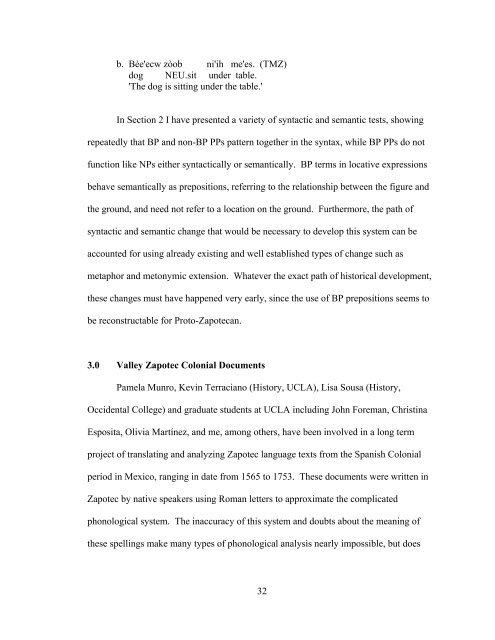The Categorial Status of Body Part Prepositions in Valley Zapotec ...
The Categorial Status of Body Part Prepositions in Valley Zapotec ...
The Categorial Status of Body Part Prepositions in Valley Zapotec ...
Create successful ePaper yourself
Turn your PDF publications into a flip-book with our unique Google optimized e-Paper software.
. Bèe'ecw zòob ni'ih me'es. (TMZ)<br />
dog NEU.sit under table.<br />
'<strong>The</strong> dog is sitt<strong>in</strong>g under the table.'<br />
In Section 2 I have presented a variety <strong>of</strong> syntactic and semantic tests, show<strong>in</strong>g<br />
repeatedly that BP and non-BP PPs pattern together <strong>in</strong> the syntax, while BP PPs do not<br />
function like NPs either syntactically or semantically. BP terms <strong>in</strong> locative expressions<br />
behave semantically as prepositions, referr<strong>in</strong>g to the relationship between the figure and<br />
the ground, and need not refer to a location on the ground. Furthermore, the path <strong>of</strong><br />
syntactic and semantic change that would be necessary to develop this system can be<br />
accounted for us<strong>in</strong>g already exist<strong>in</strong>g and well established types <strong>of</strong> change such as<br />
metaphor and metonymic extension. Whatever the exact path <strong>of</strong> historical development,<br />
these changes must have happened very early, s<strong>in</strong>ce the use <strong>of</strong> BP prepositions seems to<br />
be reconstructable for Proto-<strong>Zapotec</strong>an.<br />
3.0 <strong>Valley</strong> <strong>Zapotec</strong> Colonial Documents<br />
Pamela Munro, Kev<strong>in</strong> Terraciano (History, UCLA), Lisa Sousa (History,<br />
Occidental College) and graduate students at UCLA <strong>in</strong>clud<strong>in</strong>g John Foreman, Christ<strong>in</strong>a<br />
Esposita, Olivia Martínez, and me, among others, have been <strong>in</strong>volved <strong>in</strong> a long term<br />
project <strong>of</strong> translat<strong>in</strong>g and analyz<strong>in</strong>g <strong>Zapotec</strong> language texts from the Spanish Colonial<br />
period <strong>in</strong> Mexico, rang<strong>in</strong>g <strong>in</strong> date from 1565 to 1753. <strong>The</strong>se documents were written <strong>in</strong><br />
<strong>Zapotec</strong> by native speakers us<strong>in</strong>g Roman letters to approximate the complicated<br />
phonological system. <strong>The</strong> <strong>in</strong>accuracy <strong>of</strong> this system and doubts about the mean<strong>in</strong>g <strong>of</strong><br />
these spell<strong>in</strong>gs make many types <strong>of</strong> phonological analysis nearly impossible, but does<br />
32

















